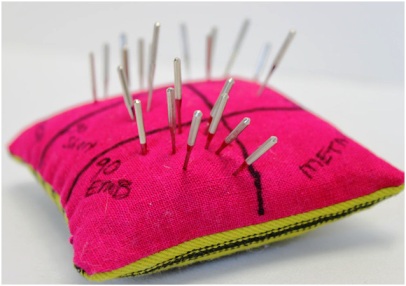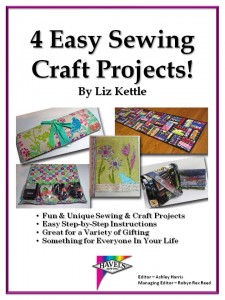Finding Needle Clarity
By Liz Kettle
 There is an amazing amount of engineering that goes into those small sewing machine needles! Each type of needle is designed for a specific task, fabric or type of thread. Learning which needle to use when, will keep your stitching time joyful instead of frustrating. Just as important, is experimenting to see which needles can substitute for each other when you break your last ‘perfect’ needle at 2am. As an example you can use an embroidery or topstitch needle instead of a metallic needle with metallic threads. Choose the embroidery needle if you are free motion stitching, and the topstitch needle can fill in when you are stitching programmed stitches.
There is an amazing amount of engineering that goes into those small sewing machine needles! Each type of needle is designed for a specific task, fabric or type of thread. Learning which needle to use when, will keep your stitching time joyful instead of frustrating. Just as important, is experimenting to see which needles can substitute for each other when you break your last ‘perfect’ needle at 2am. As an example you can use an embroidery or topstitch needle instead of a metallic needle with metallic threads. Choose the embroidery needle if you are free motion stitching, and the topstitch needle can fill in when you are stitching programmed stitches.
There are many brands of needles made. Two predominate manufacturers are Schmetz and Organ. Some machines work better with one or the other. My Bernina does not do well with Organ, but friends who have Janome machines prefer them.
It is very important to change your needles often. I change needles after about every 8-10 hours of stitching; more often when I am stitching on upholstery fabrics, paper or metal. When I am having a problem stitching, the first change I make is to put in a new needle. Your needle may look fine but microscopic nicks and a blunted tip will cause stitch problems.
I have compiled a list of the most common needles and a description of what they are best used for. Print it out and put it by your machine.
Universal: the point is slightly rounded for use on knits but they are still sharp enough for some woven fabrics. They work better with loosely woven fabrics such as homespun and flannel. I don’t find this needle to be useful for fine knits or tightly woven fabrics. Available in sizes 60-120.
Microtex/sharps: the point is sharp and they feature a narrow shaft that works well with tightly woven fabrics such as batiks, silk, faux suede and microfibers. They are good for quilting, heirloom stitching, topstitching, pintucks and edge stitching. If you want a very straight line this is the needle to use. Available in sizes 60-110.
Quilting: this needle features a slightly rounded, tapered point and is designed to stitch through thick layers and intersecting seams. Good for quilt piecing and general quilting. Available in sizes 75-90.
Embroidery: these needles have a light ball point, a deeper scarf on the back to help with loop formation with fine threads, and a larger eye to reduce friction and allow you to use specialty threads with ease. They are designed to stack the stitches close together without damaging the treads next to them. They are the first needle that was designed to stitch in many directions. Available in sizes 75-90.
Topstitch: designed to go through layers of fabric or heavy fabrics, this needle has a larger shaft to reduce flex. They also have a very sharp point to aid in obtaining a straight line. They have a very long eye and deeper groove for heavier threads or to accommodate two threads at one time. Available in sizes 80-100.
Metallic: designed especially for use with metallic threads this needle has an even larger elongated eye than an embroidery needle. It has a fine shaft and a sharp point to reduce friction on the thread. And finally, it has a deeper scarf as well as a deeper groove. The metal in the thread can wear a groove in the needle itself so they generally have to be changed more frequently. Available in size 80-90.
If you would like to find out more about needles you can find a great chart that shows all the needle parts on the Schmetz Needle website: www.schmetzneedles.com
CLICK THE COVER FOR A FREE eBOOK

